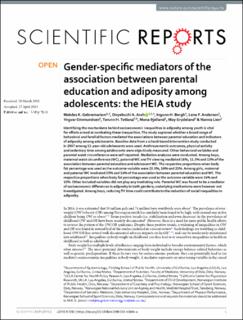| dc.contributor.author | Arah, Onyebuchi A. | |
| dc.contributor.author | Bergh, Ingunn Holden | |
| dc.contributor.author | Ommundsen, Yngvar | |
| dc.contributor.author | Totland, Torunn Holm | |
| dc.contributor.author | Bjelland, Mona | |
| dc.contributor.author | Grydeland, May | |
| dc.contributor.author | Lien, Nanna | |
| dc.contributor.author | Gebremariam, Mekdes K. | |
| dc.contributor.author | Andersen, Lene F. | |
| dc.date.accessioned | 2020-03-18T16:43:27Z | |
| dc.date.available | 2020-03-18T16:43:27Z | |
| dc.date.created | 2019-06-03T09:11:57Z | |
| dc.date.issued | 2019 | |
| dc.identifier.citation | Scientific Reports. 2019, 9, 7282. | en_US |
| dc.identifier.issn | 2045-2322 | |
| dc.identifier.uri | https://hdl.handle.net/11250/2647442 | |
| dc.description | This article is licensed under a Creative Commons Attribution 4.0 International License, which permits use, sharing, adaptation, distribution and reproduction in any medium or format, as long as you give appropriate credit to the original author(s) and the source, provide a link to the Creative Commons license, and indicate if changes were made. The images or other third party material in this article are included in the article’s Creative Commons license, unless indicated otherwise in a credit line to the material. If material is not included in the article’s Creative Commons license and your intended use is not permitted by statutory regulation or exceeds the permitted use, you will need to obtain permission directly from the copyright holder. To view a copy of this license, visit http://creativecommons.org/licenses/by/4.0/. | en_US |
| dc.description.abstract | Identifying the mechanisms behind socioeconomic inequalities in adiposity among youth is vital for efforts aimed at combating these inequalities. The study explored whether a broad range of behavioral and familial factors mediated the associations between parental education and indicators of adiposity among adolescents. Baseline data from a school-based intervention study conducted in 2007 among 11-year-old adolescents were used. Anthropometric outcomes, physical activity and sedentary time among adolescents were objectively measured. Other behavioral variables and parental waist circumference were self-reported. Mediation analyses were conducted. Among boys, maternal waist circumference (WC), paternal WC and TV viewing mediated 16%, 11.5% and 13% of the association between parental education and adolescent WC. The respective proportions when body fat percentage was used as the outcome variable were 22.5%, 16% and 21%. Among girls, maternal and paternal WC mediated 20% and 14% of the association between parental education and WC. The respective proportions when body fat percentage was used as the outcome variable were 14% and 10%. Other included variables did not play any mediating role. Parental WC was found to be a mediator of socioeconomic differences in adiposity in both genders; underlying mechanisms were however not investigated. Among boys, reducing TV time could contribute to the reduction of social inequalities in adiposity. | en_US |
| dc.language.iso | eng | en_US |
| dc.subject | epidemiology | en_US |
| dc.subject | risk factors | en_US |
| dc.title | Gender-specific mediators of the association between parental education and adiposity among adolescents: The HEIA study | en_US |
| dc.type | Peer reviewed | en_US |
| dc.type | Journal article | en_US |
| dc.description.version | publishedVersion | en_US |
| dc.rights.holder | © The Author(s) 2019 | en_US |
| dc.source.pagenumber | 9 | en_US |
| dc.source.volume | 9 | en_US |
| dc.source.journal | Scientific Reports | en_US |
| dc.identifier.doi | 10.1038/s41598-019-43604-w | |
| dc.identifier.cristin | 1702173 | |
| dc.description.localcode | Seksjon for coaching og psykologi / Department of Coaching and Psychology | en_US |
| cristin.unitcode | 150,32,0,0 | |
| cristin.unitcode | 150,31,0,0 | |
| cristin.unitname | Seksjon for coaching og psykologi | |
| cristin.unitname | Seksjon for fysisk prestasjonsevne | |
| cristin.ispublished | true | |
| cristin.fulltext | original | |
| cristin.qualitycode | 1 | |
